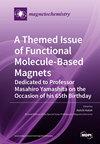羟基桥接CuII2配合物的磁结构分析:密度泛函理论和其他处理
IF 2.5
4区 化学
Q2 CHEMISTRY, INORGANIC & NUCLEAR
引用次数: 0
摘要
用密度泛函理论(DFT)对Cu(II)与通式为[Cu(L)(X)(μ-OH)]2·nH2O和[Cu。对这些配合物进行了破缺对称密度泛函理论(BS-DFT)研究,并采用了相关的分解方案,深入了解了配体和配位环境的性质对DFT预测的耦合常数的影响(J)。研究了自旋布居的影响,它与Cu-O-Cu桥接角和计算的耦合常数(J)值密切相关。使用完全活性空间自洽场(CASSCF)进一步细化模型,同时将活性空间从2个轨道2个电子(2,2)扩展到10个轨道18个电子(18,10)。使用多参考方法(n-电子价态微扰理论和差分专用组态相互作用)对这些模型进行了近似,并如预期的那样找到了J值的更好近似值。参与超交换途径的轨道也被可视化。本文章由计算机程序翻译,如有差异,请以英文原文为准。
Magneto-Structural Analysis of Hydroxido-Bridged CuII2 Complexes: Density Functional Theory and Other Treatments
A selection of dimeric Cu(II) complexes with bidentate N,N′ ligands with the general formula [Cu(L)(X)(μ-OH)]2·nH2O and [Cu(L)(μ-OH)]2X2·nH2O were magneto-structurally analyzed using the Density Functional Theory (DFT). A Broken Symmetry-Density Functional Theory (BS-DFT) study was undertaken for these complexes with relevant decomposition schemes that gave insight into the effect of the nature of the ligand and coordination environment on the DFT-predicted coupling constants (J). The impact of the spin population, which correlates well with the Cu-O-Cu bridging angles and the calculated coupling constant (J) values, was studied. The models were further refined using a complete active space self-consistent field (CASSCF) while expanding the active space from 2 orbitals 2 electrons (2,2) to 10 orbitals 18 electrons (18,10). These models were approximated using multireference methods (n-electron valence state perturbation theory and difference dedicated configuration interaction), and a better approximation of J values was found as expected. Orbitals involved in the superexchange pathway were also visualized.
求助全文
通过发布文献求助,成功后即可免费获取论文全文。
去求助
来源期刊

Magnetochemistry
Chemistry-Chemistry (miscellaneous)
CiteScore
3.90
自引率
11.10%
发文量
145
审稿时长
11 weeks
期刊介绍:
Magnetochemistry (ISSN 2312-7481) is a unique international, scientific open access journal on molecular magnetism, the relationship between chemical structure and magnetism and magnetic materials. Magnetochemistry publishes research articles, short communications and reviews. Our aim is to encourage scientists to publish their experimental and theoretical results in as much detail as possible. Therefore, there is no restriction on the length of the papers. The full experimental details must be provided so that the results can be reproduced.
 求助内容:
求助内容: 应助结果提醒方式:
应助结果提醒方式:


